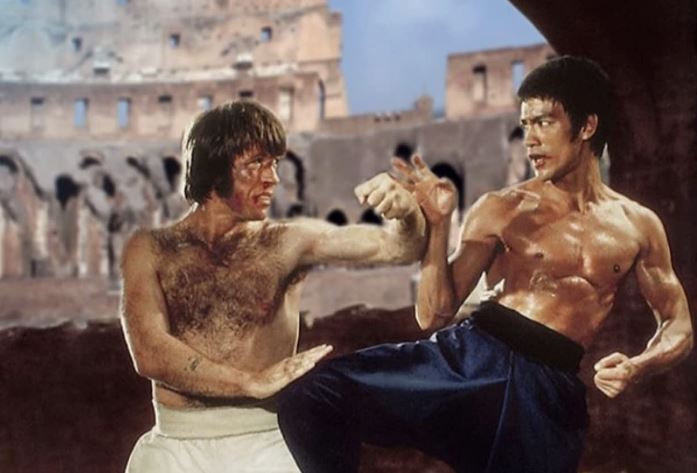
During the groovy, Colosseum-set climax of 1972’s phenomenally successful Way of the Dragon, Chuck Norris took on the legendary Bruce Lee. Next to the lithe Asian superstar, he looked fat, slow, very hairy and curiously graceless. No matter, for he played his part in a terrific dust-up that fight fans still salivate over. He followed this memorable debut two years later with the chopsocky crapfest Slaughter in San Francisco. Some unusual stuff happened in these first two supporting roles in that he played a cigar-smoking, would-be rapist, lost both climactic fights and got killed.
Surely such unspeakable humiliations of our favorite ultra-conservative, furry Christian were against the laws of physics, God or something?
Well, they clearly stuck in Chuck’s craw for he decided henceforth that things would be different. Namely, he must never lose another fight or die, even if gut-shot. Adulation would be courted by always playing the good guy, a move reinforced by the shunning of tobacco and drugs. Now while at this point in his nascent career he might have harbored the lofty goal of killing up to one hundred people a flick (probably achieved in 1985’s Invasion U.S.A.) he sure as shit would never smoke again, be caught stumbling around drunk or dreamily smear himself over the ceiling of an opium den.
Gotta be a good role model for the kids, you know?
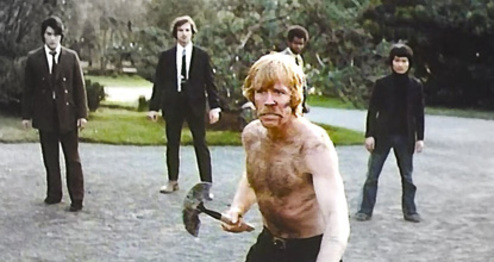
Anyhow, three years after suffering the ignominy of being kicked into a pond in Slaughter in San Francisco he put his master plan into motion, a steely course that included a penchant for blue jeans and black leather gloves, buying a bottle of blonde hair dye, performing alongside actors that were rarely more than two inches taller, always being a Vietnam vet, the increasing acquisition of facial hair, the shunning of anything approaching a boo-hoo face, and undergoing a yearly medical examination for signs of woodworm.
This methodical conquest of Hollywood began in earnest with 1977’s oddity, Breaker! Breaker!, a knockabout flick designed to cash in on the CB radio craze. Chuck plays a trucker in double denim that has to save his kid brother from a corrupt judge presiding over a bunch of punch-happy cops in a fucked-up hick town. He’s a brilliant arm-wrestler, drives an eagle-adorned van, and for the most part thinks he’s ambling through a feature-length episode of The Dukes of Hazzard. With its barroom brawls, banjo music, rampaging big rigs and a skittish horse that appears to be trying to emulate our hero’s karate prowess, I guarantee you won’t find anything else like it in Chuck’s back catalog.
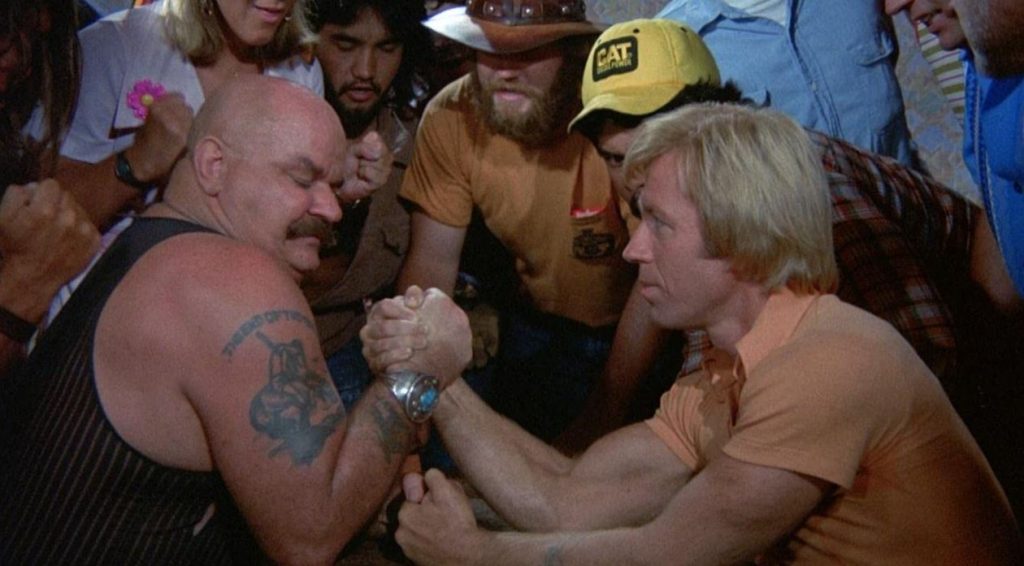
Breaker! was goofy crap, but recouped its budget nearly fifty times, launching Chuck as the main man in a run of hit movies that ranged from the numbingly dull to the amusingly mediocre. Yes, it’s easy to mock the guy’s attempts at acting, but it’s much trickier to explain such consistently impressive box office. From day one Chuck’s screen presence bordered on the bland and inoffensive, underlined by his one size fits all expression. His face never altered much whether watching a colleague get murdered, being unjustly thrown in prison, making love in the shower, attending a funeral, punching a guy out while keeping one hand in his jeans, consoling a violated girlfriend or running a samurai sword through a half-brother. Whatever happened he remained unruffled, maybe even a little dazed. It was as if he couldn’t quite grasp he was on his way to becoming a star. So why did punters flock to these simplistic, formulaic films built around a charisma-free mannequin that liked to jump in the air and twirl?
You got me.
However, in spite of possessing a patently obvious sky-high ego, Chuck did somehow manage to pull off the trick of coming across as down to earth, typified by his straightforward wardrobe and disdain for anything other than a clear-cut narrative. Barring The Octagon he simply had no interest in the clever, opaque, overcomplicated or artsy-fartsy. Was this the key to his early success? I dunno, maybe there was also something endearing about a slightly undersized he-man doing his silly spin kicks and coming out on top. Whatever the case, Chuck’s bid for stardom was boosted by Breaker!, enabling him to claw his way into the mainstream consciousness with each subsequent release.
Not that the flicks got much better, as demonstrated by 1978’s randomly-titled Good Guys Wear Black. Sporting a tash that some might call walrus-like (though no doubt its owner perceived it as a thick, finger-long dollop of yummy fudge), this one kick-started Chuck’s yen for playing Nam super soldiers. He’s a former member of an elite fighting force (that bafflingly contains one retard) who winds up on the hit list of a rising political star. Good Guys is more competent than Breaker! but it’s still a lukewarm load of old cobblers that meanders to a particularly weak ending. Like Breaker! the fights are rubbish, which is surely the main reason to watch in the first place. Nevertheless, despite the nonstop pedestrian dialogue, it does contain one classic Chuck moment when he kills a baddie via a two-footed flying kick through the windshield of an accelerating car. Only Chuck could win a head-on collision with an automobile.
Good Guys provided the Chuck Norris template, one he happily re-employed for 1979’s A Force of One. And surely its PG rating (boo!) was designed to broaden his appeal. Written by the guy who gave us French Connection and High Plains Drifter, this one represents a marked drop-off from such quality fare, especially apparent in its naff dialogue, painful plot contrivances and all-round poor acting. A bunch of unconvincing cops trying to crack a citywide narcotics ring are targeted by a murderous martial artist, forcing them to call on super-duper karate teacher Chuck for help. Er, what? They’ve got stuff like batons, guns and the legal right to use lethal force but need to be trained for two hours a day in karate? I guess Force is guilty of tapping into that late twentieth century myth (perhaps popularized by Bruce Lee the best part of a decade earlier) that a mastery of the martial arts grants you unearthly powers.

The same eyebrow-raising guff was trotted out in The Octagon, which has to be the most face-clawing of Chuck’s early efforts. In case you don’t know, this is the one in which we can hear our hero’s whispery, echoey thoughts (“Oh, my God! Ninja!“), an excruciating quirk that wears out its unintentionally funny welcome after about thirty seconds. After all, it’s bad enough having to listen to the man’s labored conversation (“Tolerance is my middle name”) without getting inside his head.
Still, given that ninjas were pretty much everywhere at the start of the 80s, I s’pose it was inevitable that Chuck would face off against these silent, fleet-footed, masked assassins who’ve ‘been outlawed for three-hundred years’. They’ve set up a training camp in Central America for the world’s worst terrorist scum, offering students such nuggets of advice as “Expect the unexpected and trust no one!” which sounds like it was scooped out of a Monty Python episode. They also insist “Only the body sleeps. The mind never sleeps” while literally wagging a finger. Then they do sneaky shit, such as dropping an unsuspecting trainee through a trapdoor to demonstrate how dumb and bovine the average non-ninja is. Honestly, they come across like an overly stern bunch of boarding school teachers, always keen to cuff someone around the back of the head for talking out of turn. Chuck, with his silky mustache firmly in place, plods through this embarrassing piffle in the vain hope of finding a plausible encounter, typified while lying on his bed and fending off two supposedly badass ninjas launching a surprise attack.
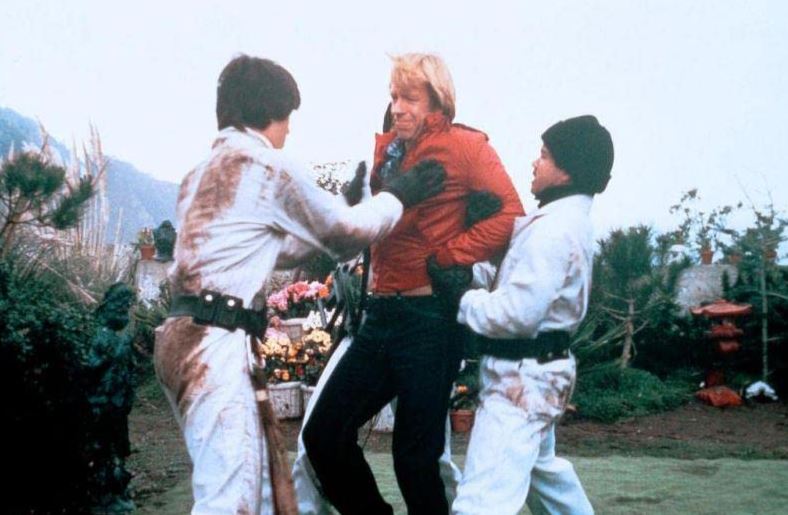
1981’s San Francisco-set Eye for an Eye is a definite improvement on the yawn-inducing Force and the hopeless, barely comprehensible Octagon. It’s still nonsense, but the pacing’s better. Here we get a man bursting into flames when struck by a car, an amusing update on Goldfinger’s Oddjob, and Christopher Lee confessing his ‘weakness for oriental women’. Chuck’s a nightmare-afflicted ex-cop on the trail of some heroin-importing triads. This involves evading a burst of machine gun fire from a distance of ten feet, beating up a gangster with both hands tied behind his back, and eventually battling a ‘Sherman tank in a suit’. Our main man, of course, takes it all in his doubt-free stride.
Now some directors throw spaghetti at the wall to see what sticks, but back in 1982 Silent Rage’s Michael Miller appeared to find such an approach far too wishy-washy. He preferred to dump everything into a bucket, give it an almighty stir, season with Tabasco and chocolate syrup, ingest in one great gulp, and then spend the next hundred minutes puking and shitting it all over the screen. That’s why this nutso effort is filled with horror, romance, science fiction, martial arts, comedy, action and crime. My God, it’s a hot mess, but it gets my vote as Chuck’s most entertaining effort during the first decade of his celluloid adventures. After all, where else do you get to see him roundhouse a zombie?
Chuck’s a small-town sheriff whose life is about to get a wee bit more hectic. First, he has to put down a double ax-murderer, a job not made any easier by his hopeless, over-eating deputy. Then a couple of naughty geneticists at the town’s hospital bring the bullet-riddled killer back to life with a secret potion, a move that sees their deranged, self-healing guinea pig rampage around town. Chuck, meanwhile, has bumped into a cute ex-girlfriend and is attempting to seduce her by sticking a finger in her ear…
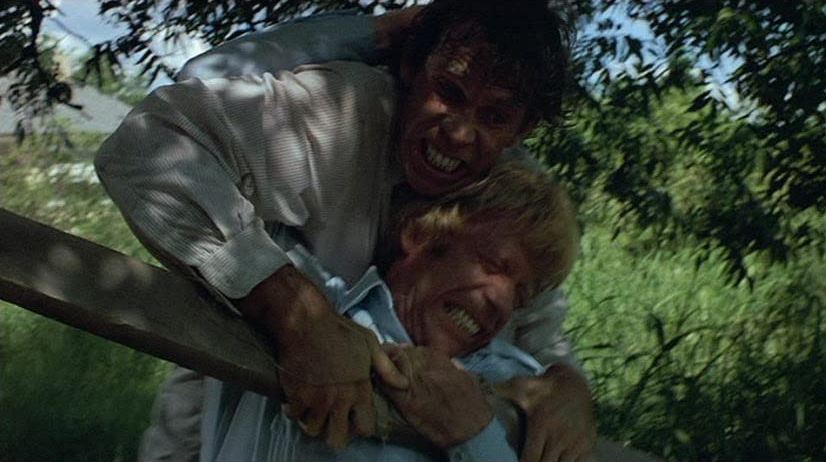
Just like Breaker! has a different feel to his other flicks so does Silent Rage. It’s certainly the first (and perhaps only) time Chuck came up against a supernatural element. Despite its slapdash, schizophrenic feel, it’s quite well directed, even if it apes 1978’s Halloween while throwing in dashes of The Shining and Every Which Way But Loose. It’s best to just kick back and revel in its monumental absurdity as shown by the hapless, bandana-wearing dwarf in charge of an outlaw motorcycle gang; a pair of scorpion-tattooed breasts; farcical comical relief; feeble wrestles with profound moral questions; and a psychiatrist determined to channel Al Pacino when he’s not performing lead surgery on any fatally wounded residents.
In the awkwardly titled Forced Vengeance, Chuck starts off fighting in silhouette, although amazingly we can still make out his tash. He’s a casino security guy in Hong Kong whose honest employer is wiped out by a dastardly rival. It’s a piss-weak outing, but at least Chuck manages to break some new ground by calling a gay guy ‘Sweet cheeks’ while threatening to burn him alive. Otherwise, he treats us to his first world-weary voiceover (“Never let your girl handle your piece”), a device that quickly gives way to hearing his thoughts again. Thank fuck they’re not the whispery, echoey sort. Perhaps the most fitting image in this crapfest is Chuck having a toilet thrown at him.
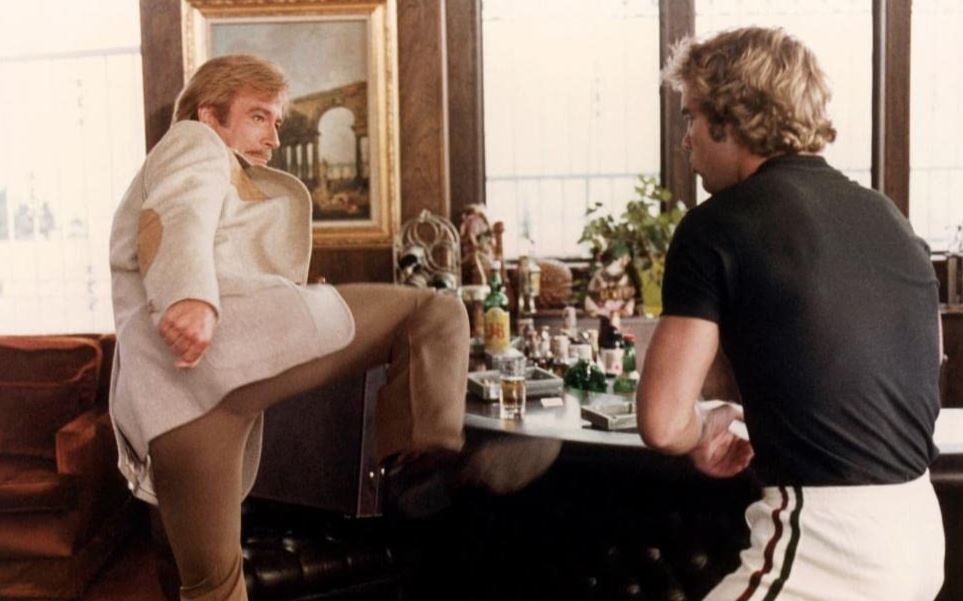
Now after reading my hatchet job on Mr. Norris’ early work, you might have reached the conclusion that I’m not much of a fan. And it’s true I think the guy never got anywhere near making a quality action pic like Die Hard, Lethal Weapon or Predator. Still, there’s nothing wrong with occasionally taking your brain out and watching a macho doofus play the same character while putting his foot through anything that moves. Chuck, of course, does deserve a bit of respect for the sort of lifelong physical discipline I can only dream about, not to mention the degree of box-office success he achieved. Indeed, by the end of 1982 he was clearly on the way up with the missing pieces of the mainstream puzzle just around the corner. These included going full beard and hooking up with the gloriously insane Cannon Films.
May this hirsute, scampering pixie continue doing his spin kicks long into senility.
Dave Franklin’s movie book Go Fuck an Iceberg! is available from Amazon and other outlets.